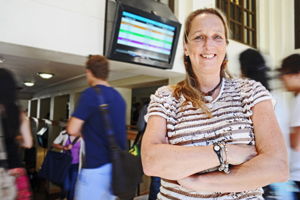No more waiting as Jammie info system is launched
28 February 2012
Thanks to a new travel information system, there'll be no more waiting in the rain for the Jammie Shuttle.
In December, UCT's Centre for Transport Studies (CTS) launched a pilot study aimed at improving transport information for the UCT community. The Jammie Shuttle Traveller Information System taps into the global trend of providing real-time information through the use of what's known as advanced traveller information systems.
In the system, buses are tracked continuously using GPS. Then, based on their current positions and historic information regarding their travel times, mathematical algorithms estimate the buses' arrival times.
This arrival time is then provided on the web, on various electronic signs and television screens around campus, and directly to commuters via sms.
For now, there are six televisions dotted around campus - in Menzies, Leslie Social Sciences, and in the Library building; with another planned for the Molecular and Cell Biology building. In addition, there are two electronic signs at the West stop outside the chemical engineering building on upper campus. Another sign outside Tugwell is in the pipeline, reports the CTS's Associate Professor Marianne Vanderschuren, the 'driving' force behind the system.
Though not complete yet - the web and sms services will be up and running soon - the system is a dream come true.
Vanderschuren, who has worked in the field of intelligent transport systems since 1996, has long nursed the idea of a Jammie Shuttle information system. A few years ago she finally secured funding to get the project off the ground. She joined forces with a group of former computer science students, who had been pondering a similar service, to start the roll-out of the project.
The maxim behind the system is straightforward - no more time-consuming waiting. "If a vehicle has broken down or is cancelled, people know that they have to find another vehicle or route," Vanderschuren says.
And the system shows potential far beyond UCT too. The City of Cape Town, for example, is keeping an eye on it.
There are many things wrong with the South African public transport system. But a service like this can be a nudge in the right direction.
"South Africa, as a whole, has very limited public transport information. In my view, real-time public transport information is one important step towards a high-quality system."
 This work is licensed under a Creative Commons Attribution-NoDerivatives 4.0 International License.
This work is licensed under a Creative Commons Attribution-NoDerivatives 4.0 International License.
Please view the republishing articles page for more information.










